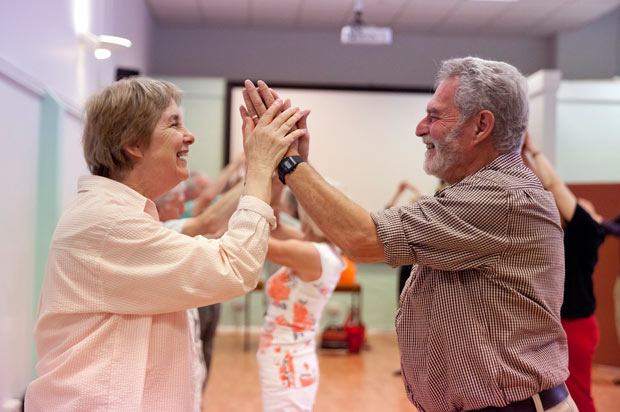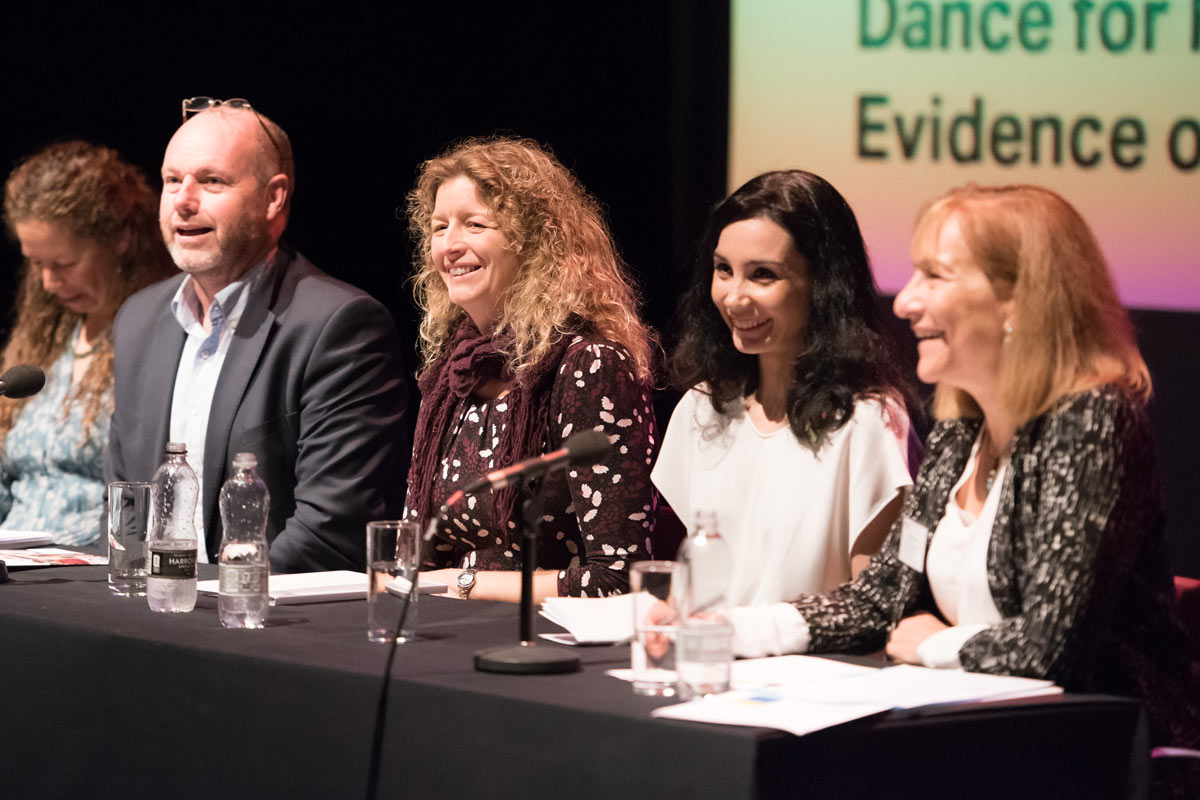
© Rachel Cherry. (Click image for larger version)
Last month English National Ballet and Roehampton University held an event at London’s Sadler’s Wells to talk about their joint work on helping those with Parkinson’s disease: “Dance for Parkinson’s: Evidence of Impact – Moving Forward”. Jann Parry reports for DanceTabs…
www.ballet.org.uk/learning/dance-parkinsons
roehamptondance.com/parkinsons
Some other relevent links:
www.danceforparkinsons.org
www.danceforparkinsonsuk.org
www.parkinsons.org.uk
English National Ballet has been running a Dance For Parkinson’s programme since 2010, basing dance sessions at its headquarters, Markova House, in London. The project was inspired by the Mark Morris Dance Groups’s programme, inaugurated in MMDG’s new dance centre in Brooklyn in 2001. Wherever Mark Morris tours, the company spreads the idea of dance for people with Parkinson’s Disease, offering free classes and training workshops. So far, they’ve established a network of over a hundred organisations in 13 countries around the world.
ENB’s involvement was outlined by Tamara Rojo, its artistic director, when a presentation was made at the Lilian Baylis Studio on 27 October 2015 of research the company had commissioned into the effects of Dance for Parkinson’s. Ms Rojo stated that ENB’s programme was an integral part of her company’s activities, not a separate entity. Participants take part in dance classes, watch performances on stage, meet the dancers, musicians and backstage staff and share in the experience of producing and performing a ballet in ENB’s repertoire.
Tamara Rojo is an eloquent advocate of the artistic benefits of dance – a case she has to make over and again to convince sponsors and politicians to fund her ambitions for ENB. So she commissioned researchers at Roehampton University to investigate, as scientifically as possible, the results of participation in the Dance for Parkinson’s programme – not so much as physical therapy but as a holistic cultural experience. Although there have been studies into dancing for Parkinson’s elsewhere, research was needed specifically in the United Kingdom to prove that what the programme offers sufferers and carers is well worth funding.

© Photography by ASH. (Click image for larger version)
The ‘Evidence of Impact’ session was introduced by Fleur Derbyshire-Fox, Engagement Director for ENB, who explained that after a pilot project in 2010, funded by a small grant from Westminister City Council, a three-year programme was established with funds from the Paul Hamlyn Foundation. In addition to ENB’s involvement, four other projects were inaugurated in Oxford, Liverpool, Ipswich and Cardiff. The research examined data from the London and national programmes.
The report of the findings was presented by Dr Sara Houston and Ashley McGill, both lecturers in Roehampton University’s Dance Department (and former dancers). Dr Houston asked us to understand the effects of Parkinson’s Disease, a degenerative disorder of the nervous system that occurs in 100 to 180 people per 100,000 of the population. Its symptoms affect movement: involuntary shaking, rigidity, difficulty with walking and speaking, and incur related emotional and psychological problems. Imagine the positive experience of finding an activity where there is no judgement of your impairment, Dr Houston said, among others who share your symptoms and interests; a place where you could take time out from thinking about your medical condition and concentrate on a pleasurable achievement.
She and Ashley McGill listed the many benefits of dancing. As their subjects said, ‘It gives me a sense of organised freedom, of being able to do something new and different, however badly. I’m using parts of my body I don’t normally use. When I leave, I’ve almost got a spring in my step. I can’t put into words how I enjoy it, but I do.’ Ballet-based dancing provides a challenging mental as well as physical workout for people with Parkinson’s and helps improve other aspects of their daily lives. It enables them to express themselves in ways that are otherwise increasingly restricted by the disease, and gives them greater self-confidence and independence. The presentation concluded with the assurance that dance’s ‘specialness comes in its ability to offer an activity that resonates deeply on intellectual, social and emotional levels.’

© Rachel Cherry. (Click image for larger version)
However, these findings cannot be shown to have clinical benefits. People who move more freely during dance sessions don’t necessarily continue to do so once they return home. Dancing is not a cure for Parkinson’s. But in the classes, music provides a stimulus that helps movement to be more fluid; touch makes connections with others in the group, as does talking about what they are hoping to achieve. That camaraderie includes family members and carers who enjoy their time in the dance studio, away from clinics and hospitals.
Their enjoyment was evident in the 7-minute film shown after the presentation of the research’s findings. The film, ‘A Window into the Studio’, has also been shown on television news reports of the research. The film shows dance participants moving together to Prokofiev’s ‘Dance of the Knights’ music from Romeo and Juliet, taking on aspects of different characters – Tybalt, Lord or Lady Capulet. There is a sense of committed performance rather than of dutiful therapy.
In the online discussion that ended the symposium, the panel of those involved with Dance for Parkinson’s in Southend, Dorset and Oxford, as well as London, talked of the need to make a case to the National Health Service and Public Health sector of government for funding. As David Leventhal, the Mark Morris former dancer and founding teacher of MMDG’s Dance for Parkinson’s Disease programme, said in a link to New York, teachers must be specially trained dance professionals, working with sensitive, knowledgeable musicians. ENB is fortunate in having such people within its organisation, as well as being able to provide access to performances and workshops. Regional centres might not be so well equipped, with lower quality classes compromising the proven benefits of the established Dance for Parkinson’s programme.
Tamara Rojo promised that when ENB moved to its new premises in City Island in the East End of London in 2018, its Dance for Parkinson’s programme would be integrated there. Classes could continue in central London, depending, obviously, on funding. Steve Ford, chief executive of Parkinson’s UK, the support and research charity, emphasised that research nationally and internationally must be shared among a network of organisations. Speaking for people with Parkinson’s, he said: ‘We want to be empowered to take control of our lives. We want to be kept fully informed about services and enjoyable activities, as well as about our medical condition.’

















You must be logged in to post a comment.